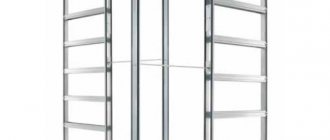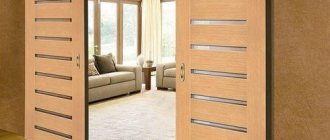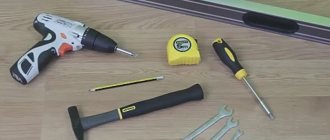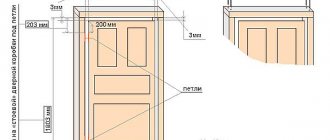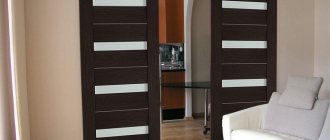Sliding pencil doors are doors that slide inside the wall and have all the advantages of a sliding and swing door. This installation method looks original and saves space. How to install pencil case doors and what is important to know for this, we will tell you in this material.
Sliding interior doors can be installed in two ways. They can move along the wall and into the wall. In order for the doors to slide inside the wall, two conditions are necessary:
1. The wall thickness must be at least 100 mm
2. The width of the doorway must be at least 1500 mm.
(Although below we will talk about one version of the cassette, which will allow you to install a pencil case door in a narrower opening - a half-pencil case)
The conditions listed above are the minimum dimensions of the cassette for pencil case doors. The door cassette is the main element for this type of door. Its essence is that this is a structure made of galvanized profile, which is mounted in the doorway, covering half of the opening, forming a continuation of the main wall into which the door leaf slides.
If it is not possible to expand the doorway, then the second option for installing a door cassette is to build a false wall from plasterboard along the main wall. The thickness of the additional wall will be at least 110 mm.
Steps to install a sliding door into a wall
There is so little space in a small apartment that even the opening of the interior door creates inconvenience. Sliding systems help to partially solve the problem, but the canvas extending behind the partition interferes with the installation of furniture. The best option is considered to be a cassette design, which provides for the sliding door to be rolled back into the wall using a pencil case.
How does a cassette sliding system work?
According to the principle of operation, cassette interior doors are no different from designs that require the door to be rolled back behind the wall. The mechanism consists of rollers and guide rails. The main difference is the ability to hide the door leaf inside the wall. This design is called a cassette or pencil case. It is made in the form of a flat box, replacing part of the wall. In addition to the sash, guide rails and a roller system are hidden inside the cassette.
The benefit of a pencil case for sliding doors is the creation of free space inside the wall; the door that rolls back into the cassette does not interfere with installing furniture close to the interior partition. The pencil case protects the door leaf from dirt, scratching by pets and other damage.
For normal operation of a sliding door, a wall thickness corresponding to the parameters of the cassette is required. The structure should form a niche that does not protrude beyond the plane of the pier. In the sliding system, the thickness of the sash and the side posts of the pencil case, as well as the gaps between the elements for the free movement of the canvas, are taken into account. The width of the cassette is always made twice as large as the doorway. The half, intended for rolling back the canvas, is hidden behind a false plasterboard wall.
How to build a false plasterboard wall
Sometimes there is a need for a double wall when there is a void between them. This is most often used for sliding doors that hide into a niche without getting in the way or attracting attention to the room. Question - what is the easiest way to make such a wall? That's right, from plasterboard.
In this article we will describe in detail the installation process of this structure.
A false wall is ideal for saving space in a room
Varieties and features
All sliding systems are identical in design. They may differ in dimensions, material, design of rollers and guide rails . The dimensions adhere to standards that imply a door height of 1.9–2 m and a width of 0.6 to 1 m. For large openings, built-in double compartment doors are installed in the wall. If you need to deviate from the standards, the cassette is made to order in the required sizes.
The factory design is supplied in its entirety. The pencil case is already folded and ready for installation. When manufactured independently, the cassette is assembled from a thick board, timber, or galvanized profile. The door leaf can be adapted to any suitable size.
Of the additional devices, the system is most often equipped with a door closer . The mechanism creates a smooth closing of the sash. For complete convenience, the sliding interior door, hidden in the wall, is equipped with automation. The canvas opens when a person approaches and closes after he passes through the doorway. The automation is triggered by sensor signals. The canvas is moved by an electric motor.
Automation is rarely installed in residential premises due to cost and impracticality. Autonomous systems are in demand in stores and other buildings where a large flow of people passes through the day.
Main advantages and disadvantages
When deciding to install a sliding door in a pencil case, you need to weigh all the pros and cons of the design. an advantage :
- Space saving. The absence of a swing sash eliminates the formation of a dead zone. You can place furniture close to the wall and it will not interfere with the opening of the canvas.
- Reduces the likelihood of injury. A person walking in the dark sometimes hits the end of an open swing door. The sensations are unpleasant and sometimes dangerous. No matter how hard you try, you won’t be able to hit the end of the sliding panel.
- Increased service life. Due to the rollers, the weight of the door leaf is evenly distributed across the frame lintels. The box becomes more resistant to loosening and does not warp. The linen hidden inside the pencil case is protected from pets and will not be smeared by children.
- The sliding design visually expands the space , creates a zoning effect, and emphasizes the modern style of the interior.
The disadvantage is the high cost . A high-quality roller mechanism is expensive. Additionally, the costs of purchasing or manufacturing a pencil case are taken into account. It is difficult to install a cassette for a sliding door yourself. If you have no experience, you will have to hire specialists.
Another disadvantage is the reduction in sound insulation . There is a gap at the bottom and top of the end of the door leaf. It will not be possible to ensure silence in the room. Additionally, odors will penetrate from the kitchen through the gaps. The problem will have to be solved by installing a powerful hood.
Instead of an epilogue
To summarize, it can be noted that the mechanism of sliding cassette doors will be relevant for a long time in almost any room, and as an interior opening device, it is simply irreplaceable (if there is a special need to save space). The cost of such a system, in most cases, will depend on the materials used and the complexity of the installation work, but in the end, these costs can be more than recouped by providing its owner with the proper level of comfort.
At the same time, in the domestic market of such systems, a certain heterogeneity of development trends is noticed, namely: the middle price segment is poorly represented. Finding cheap pencil cases is not so difficult, but their quality leaves much to be desired. According to the analysis, the premium class is best represented on the market, which is not surprising, because cabinet doors in our country are still considered elements of exclusive decor rather than practical devices.
Do-it-yourself cassette door installation
Before you start making a pencil case for a sliding door, determine the width of the opening. The design of the entire system will depend on this parameter. There are two types of cassette coupes:
- Single leaf. Door blocks are designed for standard narrow passages to the bedroom, kitchen, and bathroom.
- Bivalve. Door blocks are designed for wide passages. Often such openings are installed in the living room or when combining rooms. The design consists of two separate cassettes installed on opposite sides of the aisle. The result is combined single-leaf systems, where each leaf rolls back in the opposite direction.
When making a pencil case for sliding doors with your own hands, take into account the type of wall. The usual non-load-bearing interior partition is completely dismantled. In its place, a structure with a niche is being erected. A sliding door with a plasterboard partition forms a false wall, which is a cassette. The construction of a new wall allows you to save useful space by maintaining the original thickness.
A load-bearing wall cannot be dismantled. The frame of the pencil case will have to be attached to the surface and covered with plasterboard on top. The result will be a double thickening of the wall and a reduction in space, but there is no other way out.
The cassette compartment door is installed after the finished floor has been installed. By this time, the final leveling should be completed, and the thickness of the floor covering should be taken into account.
Related article: How to assemble a wooden door with your own hands
Installation procedure
- In order for the design of an interior compartment door to be made without errors when you make it yourself, you will need to draw a drawing and then transfer it to the wall. Using markings, they determine which areas need to be dismantled.
- When drawing up a drawing, you need to calculate the dimensions of the sliding door cabinet. Measurement starts from the sash. Its width is multiplied by 2, which determines the length of the guide rail. The height of the racks of the pencil case is calculated taking into account the thickness of the jumper, the guide, as well as gaps of about 5 mm at the top and bottom of the end of the canvas. The pencil case is made 2 cm wider than the sash. The depth of the cassette is usually limited to 8 cm.
- After performing the calculations, the dimensions of all elements are indicated on the drawing. To make a false wall, a profile is prepared. If the pencil case is mounted on a load-bearing wall, then you will need one row of racks. When assembling a false wall, instead of the removed partition, two rows of supports are installed to form a niche. The length of the racks is equal to the distance from the floor to the ceiling, since profiles are attached in these places.
- An upper jumper is installed inside the niche, and a guide is fixed to it. A similar element is mounted to the floor. It is advisable to place a rubber band under the rail to dampen the sound of moving rollers.
- The assembly of the sliding system depends on its type. Rollers can be located on both sides of the sash or only on the upper end of the leaf, and a guide knife is attached to the bottom. After installing the roller mechanism and fittings, the sash is hung on the rail. There should be a gap of 5 mm between the ends of the blade and the guide element.
They try to roll the hung door on rollers. The movement should be smooth, easy, without rumble or jumps. It is important not to forget about the limiters that serve as a stop for the sliding sash.
After successful testing of the sliding structure, the niche frame is sheathed with sheets of plasterboard. Further actions are aimed at decorative finishing of the false wall and framing the ends of the cassette, forming the door frame.
Calculation and marking of the partition
Main points
A partition with a door requires a responsible approach to the manufacture of the frame.
A plasterboard partition is not a load-bearing structural element, and therefore does not usually require strength calculations. However, if the partition includes a door, the additional load that this door will create, especially during opening and closing, should be taken into account .
Installing a plasterboard partition with a door requires a responsible approach to the manufacture of the frame, otherwise the entire wall will vibrate along with the door.
As you can see in the photo, the frame is made with a large number of transverse profiles, and vertical posts are installed quite often.
Specific figures depend on the parameters of the partition: the height of the ceiling and the length of the run from wall to wall. If the ceilings are 3 m or more high, the opening may require reinforcement with reinforced vertical posts from floor to ceiling. For reinforcement, wooden blocks or additional profiles are used.
Marking
Marking is done as follows:
- In the place where the plasterboard partition is supposed to be installed, draw a straight line along the floor, strictly perpendicular to the side load-bearing walls.
- Using a plumb line, mark two points on the ceiling and transfer the line to the ceiling.
- The upper and lower lines are connected by vertical lines, which are drawn along the walls.
- Using a level and plumb line, the verticality of the resulting plane is checked.
- Next, along these lines the profile is attached to the walls, ceiling and floor using dowels and screws 75 mm long.
- If the door is planned to be installed against a wall (as in the photo), the lower profile is made smaller by the width of the door. If it is located in the middle of the partition, the profile is divided into two parts, running from the opening to the walls.
- Then the frame is cut and assembled.
Important! For better sound insulation of the future structure, all metal profiles that are adjacent to the walls are laid on a sealing tape specially designed for this purpose.
The profiles are fastened in increments of 50-60 cm using self-tapping screws and dowels.
Application of a door built into a niche
Built-in doors are suitable for arranging the entrance to rooms and other living spaces that require saving space. In families with active children, there is a need to open and close doors frequently. For such purposes, sliding mechanisms will be more practical.
Thanks to the original design, hidden doors fit harmoniously into any modern interior. They are considered the best option for narrow corridors. If there is a niche in the hall or bedroom, doors hide built-in wardrobes and separate dressing rooms. By experimenting with a variety of materials, the door leaf can be made multifunctional, for example, used as a mirror.
In large rooms, warehouses, accordion-type systems are installed in a wide doorway. It is used as a partition to divide space into several zones. If you need to decorate both a wall and a passage, you will need several sliding panels. With this solution, all panels are moved one at a time using a cascade principle.
Sliding structures are used for glazing terraces and special seating areas. With their help, the room can easily be transformed into an open space in the warm season.
How much do pencil doors cost?
There are two leading Italian manufacturers of door cassettes on the market - Eclisse and Casseton. The cost of a cassette starts from 14,000 rubles. This is the cost of a set of good swing doors. The cost of a sliding door pencil case with a cassette will be from 20,000 rubles. , plus the installation of such a door is about 5,000 rubles. Is it worth overpaying by 50-70% for the installation of pencil case doors?
Judge for yourself. How much does a square meter of your apartment cost? Let's take an apartment of 100 m2 as an example. Pencil doors will give 8m2 of additional free space. How much does 8 m2 of your apartment cost?
But not only for the sake of saving space, pencil doors are installed. This is a more modern, more original interior solution. It's convenient to use. It does not break, and if necessary, can be easily disassembled and serviced without dismantling the wall.
There are doorways that do not require closing. For example, in the kitchen or living room. You don’t know what’s better, installing doors or just decorating the opening without doors? The most correct solution would be to install a pencil case door. When open, they are not visible, but at the same time you will always have the opportunity to close the room.
Sliding systems with pencil case
The design of hidden sliding doors with a pencil case looks like a box integrated into the wall. The rails with a roller mechanism are located in a cassette that protects the door leaf from possible mechanical damage and contamination during operation. In the open position, the sash does not take up space, which increases the usable space for arranging the room.
The thickness of the partition must correspond to the parameters of the pencil case so that the boundaries of the structure on the surface of the interior partition are not visually visible. To do this, it is necessary to take into account in advance the dimensions of the door, the thickness of the cassette racks, and provide indentations to ensure free movement of the door in the pencil case. After installation, half of the cassette is disguised under drywall.
The method of constructing the niche in which the canvas will be placed will depend on the characteristics of the wall with the opening for the door. Violating the load-bearing partitions of the building is unacceptable. In such cases, the niche needs to be completed parallel to the interior partition made of a metal or wooden frame. At the final stage, the structure is covered with sheets of plasterboard and prepared for further finishing. Wallpaper is glued to the new wall or paint is applied to match the main part of the room.
Forming a frame for the opening
The doorway should be properly designed at the stage of assembling the frame.
The part of the frame that forms the doorway is the most critical in the entire structure, as it takes on the main load.
To understand how to install a door in a plasterboard partition with your own hands, you should strictly follow the procedure:
- Two vertical posts are attached to the profiles laid on the floor and ceiling, which will be the side boundaries of the opening.
- The thickness of the metal profiles should be 0.4-0.6 mm; thinner metal is unacceptable, since the screws will turn in it.
- If the ceiling height is more than 3 m, the vertical posts should be reinforced with wooden blocks inserted inside the profiles or with double profiles.
- The distance between the posts is equal to the width of the door frame plus 2–3 cm of margin on the sides on each side.
- Next, set up the remaining vertical posts in increments of no more than 60 cm.
- Now we form the letter “P”. Between the vertical posts on the sides of the opening, we install a jumper at a height equal to the height of the door frame plus a margin of 2–3 cm.
- Then we strengthen the lintel with additional vertical posts, connecting it to the ceiling, as in the photo above.
- We install horizontal jumpers between the remaining racks.
Advice! If the wall is large and the ceilings are high, you can use reinforced profiles, which are offered by almost all modern manufacturers. Yes, this will lead to an increase in the cost of the structure, but it will also serve longer and more efficiently.
At this point, the installation of the frame can be considered complete. Next, the plasterboard sheets are installed, the plasterboard is puttyed and finished. We will not dwell on these stages in detail, since there are separate articles on this topic.
Sliding door in the wall
If the partition is non-load-bearing, then it is necessary to destroy part of the wall to form a false wall with a niche. The dimensions of the niche must correspond to the parameters of the door leaf. Such designs allow you to build both single-leaf sliding doors into the wall and double-leaf ones. This installation method allows you to leave the thickness of the partition unchanged, preserving the primary area of the room.
Pros and cons of using sliding doors
Sliding mechanisms are very popular. Designs with an internal niche for a door have the following advantages compared to hinged doors:
- Sliding curtains save space in rooms of any purpose.
- Minimal risk of injury if doors are suddenly opened from the opposite side or through negligence in the dark.
- Mobile systems last longer than standard hinged mounts. The weight of the sash is evenly distributed on the rollers, ensuring a more stable and stable position of the entire frame.
- The absence of unnecessary details creates the impression of free space.
- A variety of decorative methods make it possible to experiment with style and complement the overall design of the room.
Related article: How to open a screw lock on a garage
Among the disadvantages, one can highlight the considerable cost of the structure. Good quality parts and mechanisms are expensive. The main cost is buying a ready-made one or assembling it yourself, which is difficult to install without outside help. Therefore, you should add to the total amount the costs of paying specialists performing installation.
The disadvantage of mobile door systems is considered to be low sound insulation characteristics. Doors cannot function properly without gaps at the top and bottom of the door leaf. This nuance must be taken into account at the planning stage of specific zones separated by a partition. As a solution to help eliminate odors from the kitchen, a more powerful hood is used. Soundproofing brushes hide the cracks of doorways and get rid of extraneous sounds in the room.
Installation of the structure
Before installing the pencil case, you need to determine the width of the door opening, which depends on the type of sliding doors. Designs with one door are usually installed in small bedrooms, kitchens and bathrooms. A block of several doors fits perfectly into spacious rooms. They consist of two combined single-leaf systems.
Stages of installation work:
- Determining the type of wall (load-bearing/non-load-bearing), checking for the presence of internal wiring and pipes.
- Selecting the type of sliding mechanism (rails at both ends or only the top type of fastening).
- Installation of the structure inside or along the partition.
- Closing the pencil case with subsequent masking of the installation area.
Important nuance! Installation of cassettes is possible only after completion of finishing work on the floor surface, taking into account the thickness of the future coating.
The second stage is the construction of the sheathing
There are two types of frames that can be made for drywall.
- Wooden sheathing is cheap and easy to install. But short-lived and unreliable. Unfortunately, you will have to use a very expensive antiseptic to protect the wood from rot and mold. In this case, there is no reason to use this type.
- The metal frame is reliable, durable and practical. It can be reused, nothing will happen to it, even if it bends, it is easy to straighten. Although the price of such profiles will be slightly higher than for wooden ones.
The choice is yours, just remember one feature - if galvanized posts are quite difficult to bend, then it is difficult to find a wooden beam that is perfectly straight.
Frame installation instructions (metal):
- Initially, the guide profile is marked. For false plasterboard walls, it is installed on the floor and ceiling.
- Then the wall surface is marked for installing brackets.
For your information! Between the vertical posts there should be a distance equal to half the width of the drywall sheet. This is necessary so that the ends of the material lie exactly in the middle of the profile.
- Now use a drill to drill out all the holes.
- The dowels are inserted and the brackets and guide profile are screwed on.
- Now the vertical posts are fixed on the canopies so that they form a perfectly flat plane. To do this, you can stretch the string from one corner to the other, or use a laser level.
The brackets have many holes through which you can easily adjust the vertical stand
Don’t forget that we have a false wall, which is used for an interior sliding door. Therefore, the frame must be fixed so that the door leaf can easily hide in the niche.
The sliding door mount is also installed in advance so that it is possible to adjust the movement of the door leaf
How to make a sliding door in the wall with your own hands
Using the step-by-step guide, you can make your own interior door in the wall. First you need to make the necessary calculations and display them on the drawing. Using the finished diagram, the sections of the wall to be dismantled are marked.
To correctly calculate the parameters of the pencil case, you need to select the width of the sash. The rail measurements will be equal to twice the width of the door panel. The length of the rack is determined by summing the measurements of the lintels, guides and an additional 10 cm for gaps on both sides of the sash. Standard dimensions of a pencil case: width is 2 cm larger than the panel, depth - within 8 cm.
Then they begin to prepare the profile for the false wall. If you plan to install a cassette with the removal of part of the wall, you will need a double row of supports. For fastening along the partition line, a single profile support is sufficient.
The jumpers with guides for the rails are attached first. Placing special rubber bands under the rollers helps absorb noise when the panel moves.
When all the fittings are installed, you can place the panel on the rails, attach the sash stops and check the operation of the system. The door leaf should move smoothly into and out of the pencil case. If everything is in order, the installation work is completed by finishing the exterior and closing the box.
Hidden door mechanisms are a multifunctional solution for any interior. For long-term and comfortable use, you should choose high-quality blocks. It is most convenient to order a one-piece design from a direct distributor of the factory. Self-assembly and installation requires skills in carrying out such work.
Sliding doors sliding into the wall: features and installation
A known problem is small apartments. A good solution - sliding doors - is not always suitable: sometimes there is so little space that all the walls are filled with furniture and there is nowhere to move the panel. But if the partition is not load-bearing and can be partially dismantled, then there is still an option: sliding doors that slide into the wall.
Structurally, built-in interior doors are no different from compartment doors; they are based on the same components: a door leaf (one or two), guide rails, carriages with rollers and fittings. If desired, an electric drive. The only difference is that when opened, the canvas is hidden from view. In the converted section of the wall there is a cassette into which the door slides on rollers.
The canvas itself can be anything: wood, glass, plastic. You can choose an option that will be in perfect harmony with the rest of the doors and the interior as a whole. The roller mechanism is also no different from the standard one.
The difference is in the fittings: locks and handles should not interfere with the movement of the canvas into the wall. You need to decide on handles and locks in advance. If the sliding door goes completely into the wall, you will need a lock with a button to close it.
Related article: How to change the lock cylinder on an iron door
The second difference is that sliding doors that slide into the wall require more energy-intensive installation than compartment doors. It is necessary to dismantle part of the wall, fix the cassette, cover the structure with gypsum board and complete the repair with finishing. There will be a lot of construction waste, you need to prepare for this in advance.
It is better to buy built-in doors into the wall complete with a cassette. Buying an additional cassette later and installing it separately will be too expensive and energy-intensive. The pencil case door kit already includes everything you need - the door leaf, mechanism, fittings and cassette.
Attention: the pencil cases are different for partitions made of brick and plasterboard. This needs to be clarified when purchasing.
Final work
Don't forget about the platbands.
To finally complete the process, the door should be refined and decorated. Platbands are used for these purposes. It is best to select platbands immediately, especially those that come with the door in the set.
If there are none, you will have to select them by color. It is better to refrain from all kinds of drawings and patterns if you are not an artist or designer.
The platbands are nailed with flattened nails to the frame to close the gap and foam. The planks are cut so that they are joined end-to-end at 45° each, resulting in the desired 90°. It's simple.
If the price of cutting in the store is low, it is better to cut the planks immediately upon purchase. Otherwise, you will need a guide template or manual precision, because any deviation from the given angle can result in damage to the plank.
We nail the trims with a hammer around the perimeter of the door with a fastening pitch of 20–25 cm.
Installation sequence
1. Check the verticality of the walls and carefully calculate the opening (two widths of the canvas).
2. Dismantle the required area, if possible without unnecessary destruction.
3. Process the opening, seal the cracks.
4. Install the pencil case and secure it with mortgages. The upper mortgages will serve to securely fix the canvas, preventing movement of the structure.
5. Sew up the cassette with plasterboard: the top edge is placed along the enclosing box.
6. Install built-in doors and fittings.
7. Finish the wall.
8. Install platbands.
Sliding doors that slide into the wall are a good option to save space occupied by a regular door, but they take up 10 centimeters of room thickness due to the cassette. Therefore, the ideal option for installing them is to install built-in doors instead of self-supporting walls.
The first stage is preparation
If you do the repairs yourself, let's look at all the tools and materials that we will need during the work process.
Materials and tools used
- Drywall. It is calculated based on the total area of the walls in square meters.
- Metal profile for drywall. It will be required depending on the surface on which the wall will be built.
Note! A corner profile must be purchased for installation around the perimeter of a plasterboard wall or ceiling. It protects the end surfaces of the material from shedding and other mechanical damage.
- Dowel, nails and screws for metal. In some cases, you will need a butterfly dowel if you are hanging something on a plasterboard wall after renovation work.
- Primer and putty for grouting drywall joints.
Now regarding the necessary tools:
- Hammer or mallet.
- A jigsaw or hacksaw for metal.
- Drywall screwdriver.
- Drill or hammer drill.
- Several types of spatula: for grouting screws (small) and for grouting joints (wide).
- Building level.
- Roulette.
- Sharp knife.
Surface preparation
This process is not important; in any case, the frame will be leveled using metal profiles.
But still, before making a false wall from plasterboard, several problems should be solved:
- First, prepare all communications in advance. This is important, since after the construction of the leveling wall it will be problematic to do this.
- Secondly, remove all traces of mold, seal cracks and eliminate crumbling materials.
For your information! Thermal insulation work is carried out only after the frame has been installed.
How does a cassette sliding system work?
The sliding system consists of cassettes (they are also called pencil cases), which replace part of the wall, are masked by finishing and serve as grooves into which the door leaves slide. Installation of cassette blocks is carried out in advance - their size is 2 times the width of the opening.
The cassette is equipped with a guide, rollers, a stopper and a limiter along which the retractable blades move. The structural elements are hidden in a large flat box. The frame of the box cannot be wider than the thickness of the wall: when completed, the box is part of it. The system is continued in the opening by a frame with rails at the top (sometimes at the bottom). Sliding interior doors hidden in the wall fit very nicely into the interior of the room.
The disadvantages of the sliding system include high cost with good quality and poor quality of cheap copies.
The disadvantages of inexpensive designs are:
- insufficient insulation, gaps around the perimeter of the opening;
uneven movement (jerky) with a poor mechanism;
- undried wood leading to deformation;
- rapid wear of low quality rollers.
Door frame
You can assemble the door frame yourself.
If you have some experience working with wood or installing doors, it is better to assemble the frame yourself, since in this case the cost will be lower.
Attention! The box must be strictly rectangular and correspond to the calculated dimensions, otherwise the door will not close well. You should also take into account damper gaps and do not forget about the quality of the wood, its moisture content and thickness.
If you have the slightest doubt about your abilities, it is better to buy a ready-made door frame along with the door and hinges.
